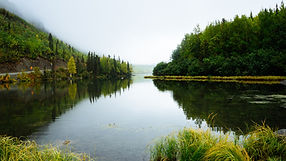

African Wild Dogs’ Relay-Hunting Strategy

African wild dogs, the greatest land hunters with 80% of successful hunting rate.
The African wild dogs are known as many names, including African hunting dog and African painted dog. The latter comes from the unique pattern and color of their coats, and it is impossible to see two wild dogs possess identical coats, so they are able to identify each other.
Despite their English names and scientific name, Lycaeon pictus, translates to ‘painted wolf’ , they are neither wolves nor dogs. All of them belong to Canidae family(犬科); however, wolves and dogs are in Canis genus(犬屬) and wild dogs are in Lycaeon genus(非洲野犬屬).
Among all the predators, African wild dogs are the most effective ones. They take advantage of astonishing co-operation and teamwork to pursue, overtake and bring down the prey.
Also, they are extreme endurance hunters, they chase the prey for lengthy distances, and never give up until they hunt the prey down. The following content will be introducing one of the most commonly seen hunting strategies- relay hunting strategies.
Firstly, seek and target.
Different from the big cats approaching their preys slowly and stealthily, wild dogs never conceal themselves. Instead, they seek for the preys in pack of 6 to 20 or more and trot openly. Once the wild dogs determine to hunt, they move quick, and as soon as they spot the preys, they lower their ears into hunting position, which means that they are ready to act at any time.
Next, sneeze to vote.
A research by Walker et al (2017) has showed that “the decision by a pack to get up from rest and hit the road to hunt as a collective pack is a democratic one, albeit with a twist- votes are cast by ways of sneezes.” In other words, the pack will move to hunt only when the sneezes meet the specific threshold. Furthermore, the sneezes of dominant wild dogs hold more weight than the others in the rally. After the vote, the hunting begins.
Later, break off and rejoin.
Once they rush into a herd of prey, the preys separate rapidly in order to scatter the attention. However, wild dogs also deform into a smaller pack to chase for the herds. As soon as one of the packs find the easier victims, they summons their companions to rejoin them.
Afterwards, relay hunting.
This is the crucial process to see how they collaborate with each other and work as a team. In tracking their prey, they form a line and lead by the wild dogs one at a time.
If the front dogs get tired, they descend to the back of the line to rest. The strategy allows them to run for long distance without exhaustion.
After that, kill!
Through the long-distant chase, the prey must be fatigued and its speed must be reduced consequently. Therefore, here comes the opportunity for the wild dogs, they try surrounding the prey together and making use of their curved, bladed-like teeth to stop the prey. After that, they immobilize it by biting its nose or ears. They simply tear the victim apart rather than choke hold or a kill bite.
At last, enjoy and share.
They once again demonstrate their cooperation by sharing foods with each other. They will finish the prey together as soon as possible to prevent other predators from plundering their food, and later regurgitate the foods for the cubs after returning their caves.
In addition to the common relay hunting strategies, which contain seek and target, sneeze to vote, break off and rejoin, relay hunting, kill, as well as enjoy and share, they adapt to different approaches based on the size of the prey and the situation of the terrain.
No matter which approach they utilize, the main concept will always involve “team work”. This is why they have such high successful hunt rate.
References
Walker, Reena H.; King, Andrew J.; McNutt, J. Weldon; Jordan, Neil R. (1862) "Sneeze to leave: African wild dogs (Lycaon pictus) use variable quorum thresholds facilitated by sneezes in collective decisions". Proc. R. Soc. B. 284: 20170347, 2017. doi:10.1098/rspb.2017.0347
.jpg)





